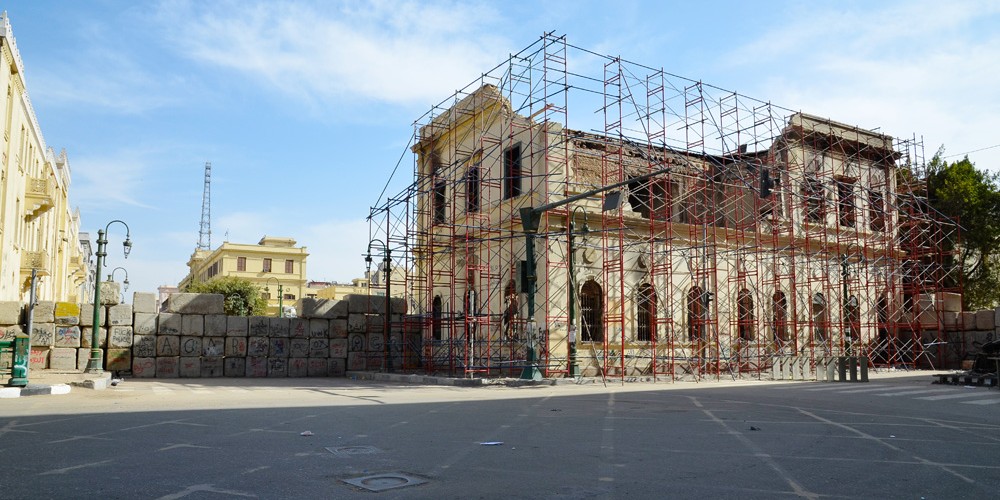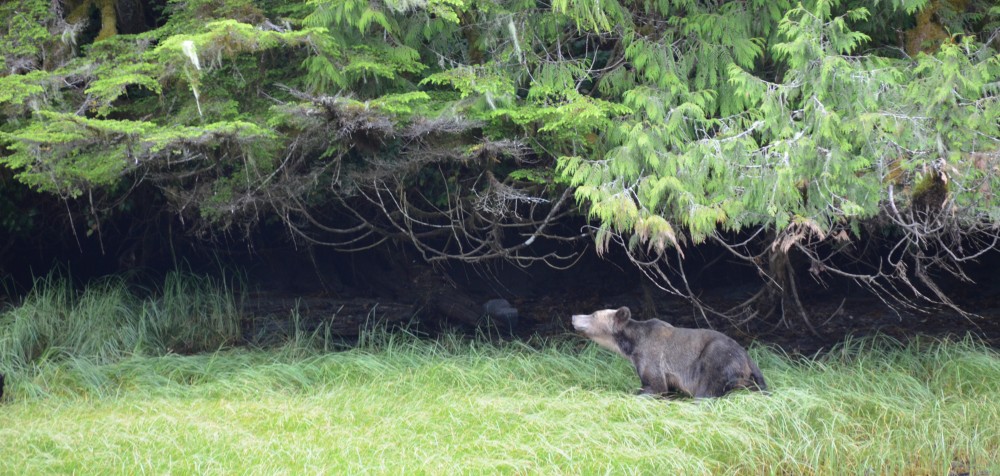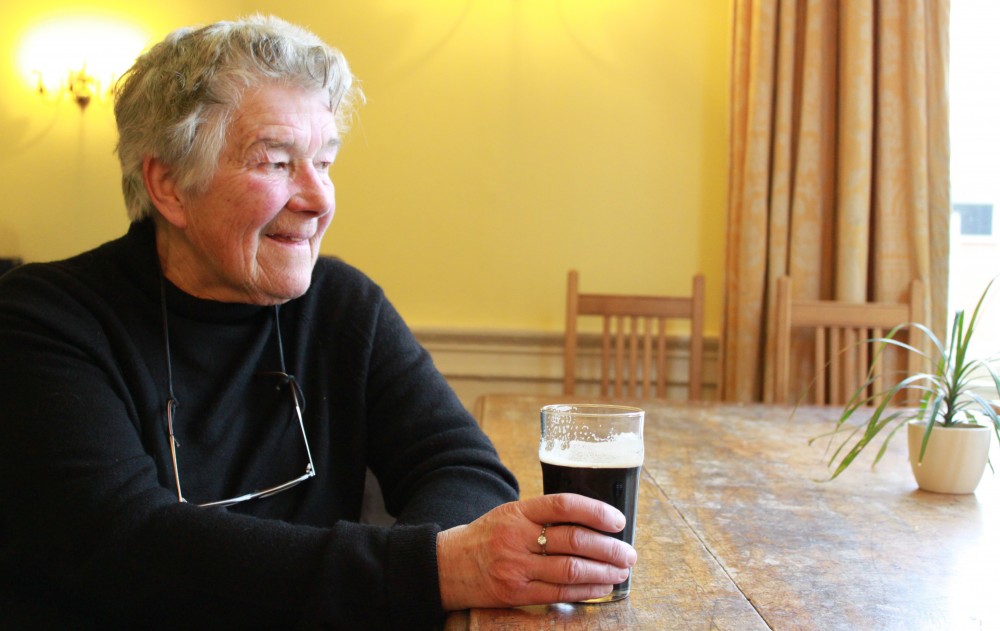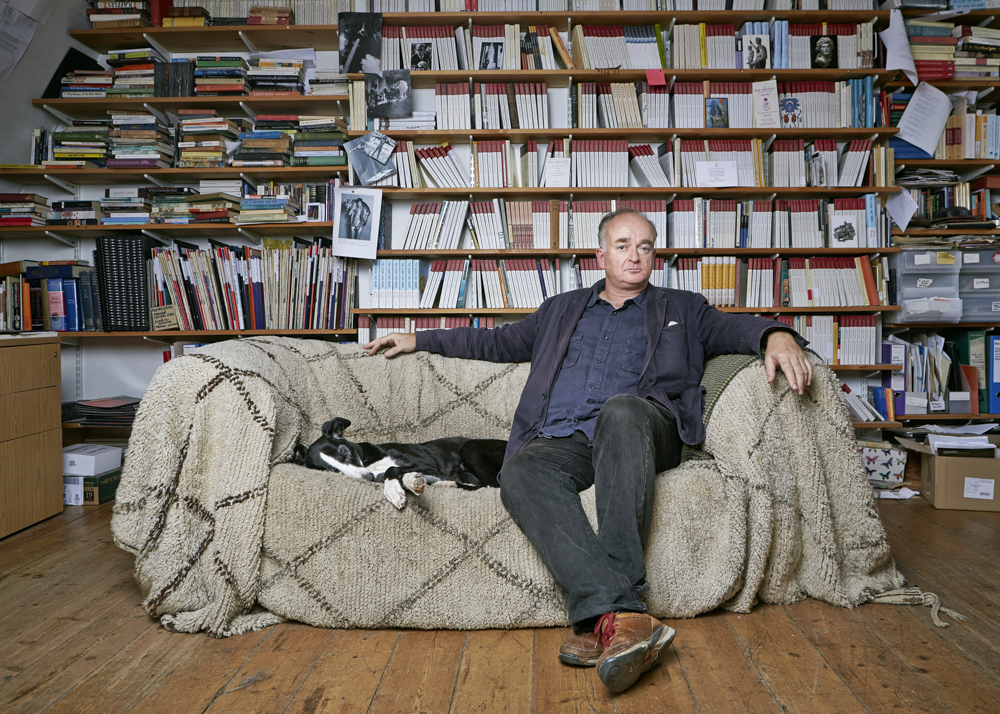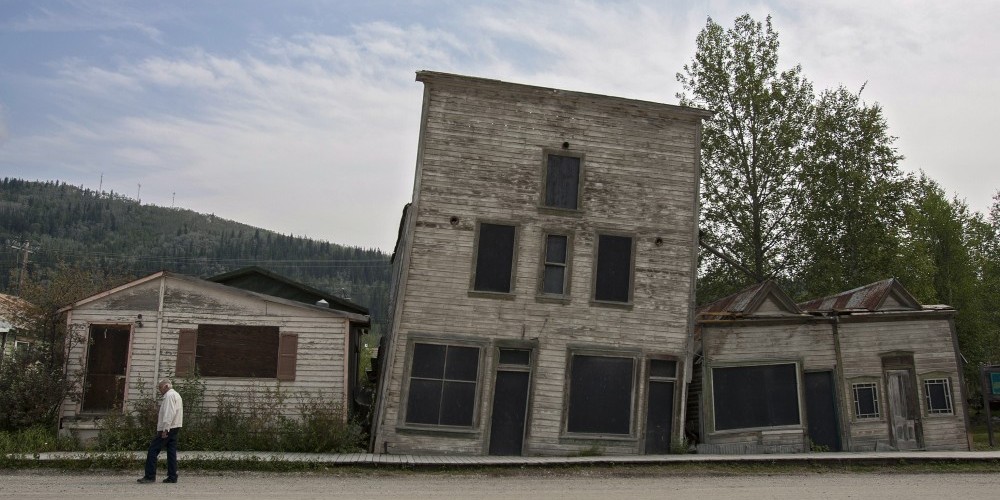“Are you spying on us?” The tall boy with curly dark hair is laughing even as he asks the question. I’ve got the camera pointed at the 1920s mosaic tiles in front of Café Groppi, a block from Cairo’s Tahrir Square. He’s laughing because just by being here, I’m part of the joke. Beware of foreigners, the military regime has been saying. Tourists are spies, working to bring down our government.
Since the first waves of the Egyptian revolution receded and a small group of high-ranking military officers known as the Supreme Council of the Armed Forces, or SCAF, took official power in February 2011, interesting things have been happening. Faith in the army, once regarded as the guardian of the state, has dried up. “The army isn’t doing so well,” my friend “Ahmed” wrote from Cairo a year after the revolution began, “and it needs to reassert its presence in politics which usually means fabricating violent events so they can with the flick of a switch have it all stop (since it is they who start it)…but anyway, nothing is clear.”
That boy at Café Groppi was joking, but he was also right. I’m not spying, but I’d like to know what really happened at the Institut d’Égypte in December 2011. The institute that Napoleon founded in 1798 to conduct research for his Egyptian campaign contained almost 200,000 volumes, mostly eighteenth and nineteenth-century French-language texts. But the question remains: of this total, how many were manuscripts and how many books? Gathering numbers is as difficult as pinning down the event.
The fire that destroyed the Institut started, so one story goes, when members of the army were positioned atop their own nearby building. This building goes by a different name in each source: the council building, the cabinet building, or the ministry building. At the same time, protesters were holding a sit-in outside of the “cabinet building”–this name stays consistent. Videos show men in the green and beige uniforms of the Egyptian army, along with men in civilian dress, throwing objects at protestors from the entrance roof of a high-rise. The Institut happened to be in the way of their aim, said one visitor, and caught fire.
The state news agency and TV station had a simpler version: the protestors were aiming Molotov cocktails at the Institut.
Others told a mixed story: the protestors were fighting back, aiming Molotov cocktails at the stone-throwing soldiers above them. One or more went in the wrong direction, and hit the Institut.
Ownership of that cocktail aside, twenty-four hours before the Institut d’Égypte was lit on fire, an anchorman at the Capital Broadcasting Center (CBC) channel, a new station launched in July 2011 by a friend of Gamal Mubarak, announced the building was burning.
It was December 16, 2011, a Friday, the first day of the weekend, and Khairy Ramadan was hosting his talk show. He could have been reading off his prompter, or his notes, relating what he thought was breaking news. The Institut d’Égypte is burning, said Ramadan, who anchored for state television before joining CBC.
The director of the Institut, Mohammed al-Sharbouni, called in on the air; he’d heard Ramadan’s broadcast and immediately phoned his staff at the Institut, a block off Tahrir Square, and nothing was wrong. There was no fire; it was a mistake.
Except that twenty-four hours later, the building was burning. While quotes on the damage from Al-Sharbouni appeared in various news sources, there was no mention in the international press of Khairy Ramadan anticipating the fire by more than a day. The truth about this CBC broadcast is equally hard to pin down; I learned of it from Ahmed.
Whether that unlabeled Molotov cocktail that lit the Institut roof on fire was thrown by a protestor, by military, or by a plainclothes policeman, is a matter of where one already stands. What’s certain is that among the losses was one first-edition copy of the Description de l’Égypte, a twenty-four-volume set printed in the early 1800s. The Description was rare; of a first run of a thousand copies, only fifty remain in the hands of libraries around the world.
Some thirty thousand books were rescued from the Institut by locals who carried materials out of the still-burning building. One man rescuing a book held it up to the camera: Wissenschaft, part of the title read. “Knowledge,” charred on all four sides.
Knowledge is what’s being fought over here, and cultural riches are being used as pawns. Only here, it’s not only the pawns that move from square to hand; the chessboard itself shifts. Antiquities disappear in hard-to-document instances, such as a small downtown Cairo museum closing down for “renovations”; decades later, it remains walled-up and silent. Where are its collections? Walls and blockades move around the city, as if by shifting the landscape, the regime can change the truth. Protests, sit-ins, and strikes continue; so does the crackdown on public space. Along with the new walls, streets change from one-way to two-way overnight and back again.
I came to Cairo with my own questions: where exactly was this “cabinet building,” the one referred to in every article but not labeled on any maps, where the army perched to attack protestors on the ground? How did the Institut get “in the way”? I’d stared at the maps and the articles, but these were no help, so I wrote back to Ahmed. Seven years ago, we’d crossed paths at MIT, working on the same research project in Islamic architecture; now he was doing doctoral work on the urbanism and architecture of 1960s Cairo. “Please come,” he answered. “Keep in mind that the January 25 anniversary is upon us so things might get a bit messy around that time for a few days.”
Two days before my arrival, 74 soccer fans were killed in a stadium in Port Said while soldiers stood by. The country went into a three-day mourning period. “This week might turn out to be more exciting than you anticipated,” Ahmed wrote. “Cairo university student unions announced a general strike and other universities may follow. I think SCAF is cooking something up.”
The day before I arrived, another CBC anchor, Lamis el-Hadidy, announced the burning of the tax building–four hours before it began.
Ahmed and I walk to the Institut two days later. We make our way through the declining neighborhood of Garden City, posh in the days before suburban flight came to Cairo, and past the American embassy with a sand-brown Egyptian tank parked outside its entrance. We cross over the triangle of roads and blocked traffic in front of the American Research Center in Egypt, then swing right and pass a church with wedding guests in suits and long dresses standing on its steps.
At the corner of el-Sheikh Rihan and al-Qasr al-Aini streets sits the burned-out shell of the Institut. Its two stories are wrapped in red scaffolding. Not an architecturally special building, it wasn’t always located at a closed corner, but since the fire two new walls of large stone blocks, about a meter square and three or four levels high, have been built on either side of the building. The Institut has been turned into a wall, a large roadblock. And this shuts off access to Tahrir Square from the southeast People have tried to budge those stones; failing, they’ve blanketed them in graffiti. “Fuck Police,” says one stone block.
Fifty meters across the intersection is the rear corner entrance to the Mogamaa, a ministry building where Egyptians pick up their passports and birth certificates. This is where we stop. “This is why people don’t believe the [official] story of the Institut fire,” Ahmed says, pointing to the dusty ground, then across to the Institut. “This is where a fire truck always stands. Institut–” he points again across the street, then to our feet–“fire truck. Fire truck, Institut. See?”
Why was the fire truck not present on that day, or not used? The blaze raged for more than twelve hours, the Institut’s director, Al-Sharbouni, told The Guardian. Firefighters arrived late on the scene, and when they did, they flooded the building with water and added to the damage. The Nile is no more than a ten-minute walk away. A taxicab could have carried water to the building in those ten minutes. Mohammed al-Sharbouni did not hold back in an interview with Al-Akhbar’s Radwan Adam: “It is the revolutionaries who saved the Egyptian Museum from looting in the first days of the revolution, and they participated in salvaging a number of intact books from the Institute. Whoever burned the Institute did so to benefit from the continued chaos in the country.”
I look up at the huge Mogamaa ministry, with its fourteen stories looming over the edge of Tahrir. After the fire at the Institut began, the army invaded Tahrir: soldiers jogged into the square in packs, chasing protestors and beating them with clubs while protestor’s tents burned in front of the Mogamaa. On the far side of Tahrir is the Egyptian Museum and Mubarak’s former headquarters, still reeking of ashes from another fire. A fire started by Mubarak’s own camp, people say, and then blamed on protestors.
Inside the tunnels surrounding the Tahrir Square metro stop, vendors sell small white masks, an optimistic rectangle of paper to put over your mouth and nose with two string loops for your ears. The air still holds the peppery smell of tear gas. A man is selling t-shirts, red and white and black and saying Egypt, freedom, Tahrir, all hanging along a railing along the multiple lanes of traffic that block pedestrians from the Egyptian Museum and the Nile.
We photograph the new murals just off Tahrir: the motorcycle angels, the ones who ride into the midst of the fighting and rescue the wounded. Modern takes on ancient Egyptian motifs: women in multicolored dresses tear their hair, mourn a pharaoh. Bundles of herbs lie on the sidewalk, spelling out words. For the martyrs. While our cameras snap the polychrome walls and the people standing in front of them, including one boy holding his shoe over SCAF leader Field Marshal Tantawi’s head, I hear other cameras clicking. We are not only recording the scene–we are in the picture now. Part of the story. A man comes up and holds out his palm: a small tube like an oversized bullet. Tear gas. “Look,” he says, “made in the USA.”
Past the murals, two more stone walls have been built; a small boy waves an Egyptian flag on top of a barricade in Youssef el-Gendy street, one block north of the closed section of el-Sheikh Rihan. An enormous stone has been partially dislodged from the other wall, the one facing downtown. How many neighbors and shopkeepers did it take to budge that chunk of stone a few necessary feet, so they could reach their homes and businesses? People step through the opened space, going to Tahrir or back in the normal course of a working day.
Ahmed tells the CBC stories to one of the organizers of Mosireen, an activist group that works with donated equipment to edit video footage of the revolution and post it online. Mosireen is tucked away in an apartment building, with no sign but the giveaway of young people coming and going. Its members are internationally savvy, confident and determined. On the computer screen in front of us, a young woman narrates, with subtitles in English.
I tried to run, she says, and then the police shot me three more times. Her face is bruised, she has one black eye and the red marks on her forehead match the red subtitles. Her interview is spliced into more video footage, night shots in black and white of gunfire, people running down a street, explosions. The revolution is not finished, says a Mosireen member. Not completed, as the authorities would like to depict it, with government in the secure hands of the military.
On the street outside, it’s growing dark. We walk past truck after truck, each one dark blue. State security, backed up to the curb. Under the truck camper roofs, young men sit in twos and threes, their heads bunched together over teapots on hot plates, small cups in their hands. Their eyes follow as we pass.
The plainclothes guards follow us around the Egyptian museum the next day; one, a young man in shiny black shoes and a dark wool coat, pulls Ahmed aside. No looking in the corners, he says. I am staring at images of Hathor in a glass case when another guard, this time in sneakers and a Nike jacket but with the same gelled hair and air of disinterest, comes circling around the room. When we make eye contact he stops, looks hard at me, and then goes straight to Ahmed.
“She’s not to photograph anything,” he says.
One night around nine, we leave the Town House Gallery and search for a bar, walking down a street parallel to Falaki. There are no street lamps, and the apartment windows above are all shuttered, with no lamps behind them. Some of the buildings retain their old ornament: plaster cherubs, slim windows doubled after the Venetian Gothic style. All are damped down with dust into a similar color. Cars approach, none with headlights on; a few flash them as they approach, others only deliver a light, informative honk. Only the ground-floor openings cast light where men sit around a television, watching a live broadcast of protests at the Ministry of the Interior.
“It’s just a few blocks from here,” Ahmed says. We’ve just turned on a side street towards Falaki, almost at our destination, when we see people moving and hear shouts at the end of the street. “I think we should definitely not go that way,” Ahmed says, and we wheel around, back to the dark block. The violence is becoming normalized, he says. In the beginning, people were afraid, they reacted, they closed up the shops. Now they stay open.
We land in the Grillon restaurant and eat chicken liver under the glass-roofed courtyard and feed pieces to a friendly cat. Ahmed orders a beer off the menu, something that could change if the Salafists come into power in the presidential elections that begin this May. Pushing out the military opens the way to all comers along the spectrum: dictatorship, secular democracy, an Islamic state.
On a large television screen is a broadcast of the ruling military council: a man with a comb-over talks from behind a yellow podium fronted by flowers, their blooms and leaves Kodachrome-dense. A red-red carpet runs down a center aisle between rows and rows of old men, their olive uniforms drab against the painfully bright blue of the chairs.
The books that volunteers rescued from the Institut were taken to the Dar al-Kutub, the National Library, where their pages were separated and dried in the first step of a conservation process that may take years. Images of the Institut’s book stamps are being shared in an effort to catch any volumes heading for private collections, and the emir of Sharjah in the United Arab Emirates, Sheikh Sultan al-Qasimi, has promised to finance the entire building restoration.
The arguments have moved on from the fire itself to the state of the building: it’s stable enough to enter, it’s about to collapse, its exterior walls are fine. And the books: should they be frozen or dried, and how many of them were there, and what did they really mean to the country? But there are no solid answers, only more questions; with every passing day, less is known.
Mohammad al-Sharbouni understood this. Radwan Adam described him standing outside the burning Institut in tears: “Disaster, disaster. The history of Egypt is burning, people!”
Ophelia John writes on landscape, cultural heritage, and what connects people to place. Her travel writing has covered Bolivia, Switzerland, Italy, Egypt, and Germany. For more information, visit opheliajohn.com.
Ruediger John is an Austrian artist. He creates situative, installative, interventionistic, research- and publication-oriented works and exhibitions and has published and taught on Artistic Research and Systemic Art. Find out more about him here.

